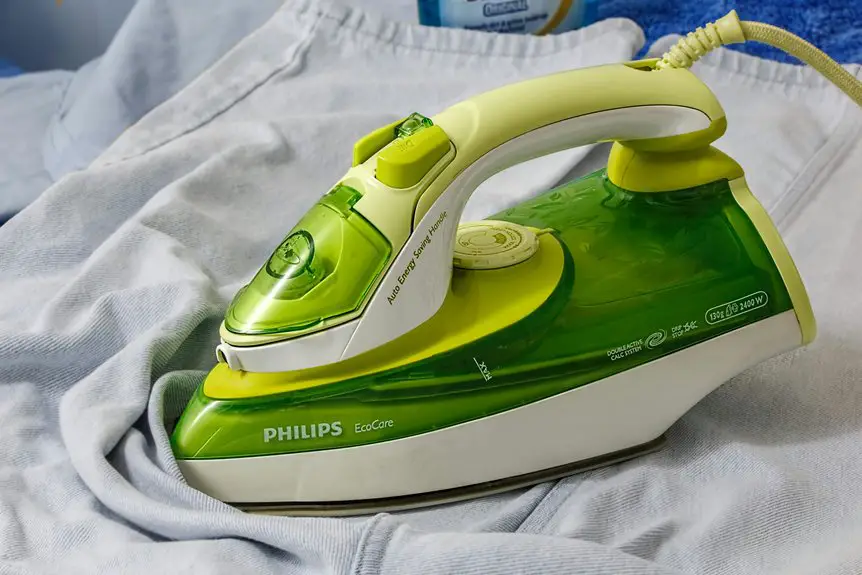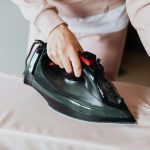If your clothes look more wrinkled after ironing, it could be due to several reasons. You might be using the wrong temperature, which can scorch delicate fabrics. Insufficient moisture and steam can leave creases stubbornly intact. Poor ironing techniques, such as not applying even pressure, can also contribute to the problem. Also, consider the fabric type—some materials crease more easily. Discovering the right methods can help enhance your ironing results and keep your clothes smooth.
Table of Contents
Key Takeaways
- Using the wrong iron temperature can scorch fabrics, leading to stubborn wrinkles instead of smoothness.
- Insufficient steam and moisture during ironing can cause new wrinkles to form rather than eliminating existing ones.
- Rushing through the ironing process may result in missed spots and uneven results, leading to more wrinkles.
- Incorrect fabric handling, such as improper back-and-forth movements, can create additional creases instead of smoothing them out.
- Inadequate post-ironing care, like not hanging clothes properly, can lead to re-wrinkling after ironing.
Incorrect Iron Temperature
One common reason your clothes end up more wrinkled after ironing is using the wrong temperature. If you set your iron too high for delicate fabrics like silk or polyester, you risk scorching them, which creates stubborn wrinkles.
On the flip side, if you use a low setting on thicker materials like cotton or linen, you may not remove all the wrinkles effectively.
Always check the care label on your clothing to determine the recommended iron temperature. Adjusting your iron accordingly can make a significant difference in how smooth your garments look.
Always refer to the care label for the ideal iron temperature to achieve perfectly smooth garments.
Taking this extra step guarantees you’re not just pushing wrinkles around but actually eliminating them, leaving your clothes crisp and fresh instead of wrinkled and burnt.
Insufficient Moisture and Steam
If your clothes are still wrinkled after ironing, insufficient moisture and steam might be the culprits.
Fabrics need some moisture for the heat to effectively smooth out wrinkles, and steam plays an essential role in this process.
Adjusting your ironing techniques to incorporate more moisture can make a significant difference in the results.
Importance of Fabric Moisture
While you might think a hot iron is all you need for a crisp finish, the moisture in your fabric plays an important role in achieving the best results.
Without sufficient moisture, your clothes can become even more wrinkled after ironing. When fabric lacks moisture, the fibers can’t relax and reshape properly, making it harder for the iron to do its job. This can lead to stubborn creases that just won’t budge.
To combat this, consider lightly misting your garments before ironing. A damp cloth can also help.
Role of Steam
Steam plays an essential role in achieving wrinkle-free clothes, and without it, you might struggle even more with stubborn creases.
When you iron, the heat alone isn’t enough to relax the fibers in your fabric. That’s where steam comes in. It adds moisture, helping to soften the fibers, which allows them to reshape more easily.
If you’re not using enough steam, you may find that your clothes remain wrinkled or even worse, develop new creases during the process. Make sure your iron has a steam function and use it generously.
If your clothes look more wrinkled afterward, it’s likely due to insufficient moisture and steam, so don’t skip this crucial step in your ironing routine.
Ironing Techniques Adjustments
To achieve the best results when ironing, you need to adjust your techniques, especially if you’re dealing with insufficient moisture and steam.
Start by ensuring your iron’s steam function is working properly. If your clothes are still wrinkled, consider lightly misting them with water before ironing or using a spray bottle. This additional moisture can make a significant difference.
Also, adjust the temperature setting according to the fabric type; too high can scorch your clothes, while too low won’t smooth out wrinkles effectively.
Move the iron slowly and steadily, allowing it to glide over the fabric.
Finally, don’t forget to hang or lay your clothes flat immediately after ironing to prevent new wrinkles from forming.
Fabric Type and Composition
When ironing, the type of fabric you’re working with plays an essential role in how wrinkles respond.
Plant-based fabrics like cotton often behave differently than synthetic materials, which can affect your results.
Understanding the molecular structure of these fabrics can help you choose the right approach to achieve a smoother finish.
Fabric Molecular Structure
Understanding fabric molecular structure is essential for tackling the issue of wrinkles after ironing. The way fibers are arranged at a molecular level affects how they respond to heat and pressure. Different fabrics behave uniquely, leading to varying wrinkle outcomes.
Here are three key factors to evaluate:
- Fiber Type: Natural fibers, like cotton and wool, tend to hold moisture and may crease more than synthetic fibers, such as polyester, which are often more resilient.
- Fiber Structure: The arrangement of fibers—whether they’re tightly woven or loosely knitted—can impact how easily they wrinkle.
- Chemical Treatments: Many fabrics undergo treatments that alter their molecular structure, enhancing wrinkle resistance or, conversely, making them more prone to creasing.
Plant-Based Fabrics
While many people appreciate the comfort and breathability of plant-based fabrics, their composition can greatly influence how wrinkles form after ironing.
Fabrics like cotton, linen, and bamboo have natural fibers that can absorb moisture and retain heat. This means they might need a bit more care during ironing to maintain a smooth finish.
For instance, cotton tends to wrinkle easily, especially when damp, while linen can be more prone to creasing due to its stiffness. To combat this, using the right heat setting and ensuring your fabric is slightly damp can help.
Additionally, blending plant-based fabrics with synthetic fibers can enhance their wrinkle resistance, making them easier to manage after ironing. Always check the care label for the best results.
Synthetic Fabric Considerations
Plant-based fabrics have their unique challenges, but synthetic fabrics offer a different set of considerations regarding wrinkles after ironing.
When dealing with synthetics, you’ll want to be mindful of a few key factors to keep your clothes looking sharp:
- Heat Sensitivity: Many synthetic fabrics, like polyester and nylon, can melt or become damaged at high temperatures. Always check the care label before ironing.
- Static Electricity: Synthetics tend to generate static, which can make wrinkles seem worse. Using a dryer sheet or fabric spray can help reduce this effect.
- Moisture Retention: Some synthetic fibers repel moisture, making it harder for wrinkles to relax. Consider using steam or a damp cloth when ironing to help smooth them out effectively.
Inadequate Pressure During Ironing
If you don’t apply enough pressure while ironing, your clothes may end up looking just as wrinkled as before.
The key to a smooth finish lies in the pressure you exert on the fabric. When you lightly glide the iron over the surface, it won’t effectively eliminate the wrinkles.
Instead, focus on pressing down firmly, allowing the heat and steam to penetrate the fibers. This combination helps to relax the fabric and release stubborn creases.
Remember, applying even pressure across the entire garment is essential. If you skip this step, you’ll find that your efforts were in vain, leaving you with clothes that still need attention.
Poor Ironing Techniques
Even with the right tools, using poor ironing techniques can leave your clothes looking wrinkled and unkempt.
If you’re not careful, you might be creating more wrinkles instead of removing them. Here are three common techniques to avoid:
1. Ironing in a hurry: Rushing through the process can lead to missed spots and uneven results.
Take your time to guarantee every area gets attention.
2. Skipping fabric care: Not checking the fabric type can cause you to use the wrong heat setting, damaging delicate materials.
3. Incorrect movements: Using a back-and-forth motion instead of smooth, straight strokes can create creases instead of removing them.
Troubleshooting Persistent Wrinkles
Why do those stubborn wrinkles keep showing up even after you’ve ironed? First, check your fabric settings. If the temperature’s too low, you won’t effectively smooth out the wrinkles.
Make sure your iron’s steam function is working; steam helps relax the fibers. Also, consider the order of your ironing. Start with lighter fabrics and finish with heavier ones to avoid re-wrinkling.
If you’re still facing issues, try hanging your clothes immediately after ironing. This allows gravity to help keep them smooth.
Finally, store your clothes properly; crowded hangers or tight folding can create new wrinkles. By addressing these factors, you can troubleshoot persistent wrinkles and enjoy a crisp, polished look every time you dress.
Frequently Asked Questions
Can Humidity Affect the Effectiveness of Ironing Clothes?
Imagine stepping into a sauna, steam wrapping around you. Humidity can definitely hinder your ironing efforts, causing clothes to absorb moisture, making it harder for you to achieve that crisp, smooth finish you desire.
How Often Should I Clean My Iron?
You should clean your iron regularly, ideally every few months, to prevent buildup from starch and minerals. If you notice residue or water spots, it’s time for a deep clean to maintain its performance.
What Is the Best Way to Store Ironed Clothes?
Imagine a neatly stacked tower of freshly ironed shirts. To keep your clothes looking crisp, hang them on padded hangers, fold them gently, and store them in breathable garment bags, avoiding cramped spaces and moisture.
Can Over-Drying Clothes Lead to More Wrinkles?
Yes, over-drying your clothes can definitely lead to more wrinkles. When fabric dries too much, it loses moisture, causing fibers to become stiff and prone to creasing. Always aim for a balanced drying time!
Are There Specific Fabrics That Are Harder to Iron?
Yes, some fabrics, like silk and linen, can be trickier to iron. Their delicate fibers require careful handling to avoid damage. You’ll find that synthetic blends may also resist smoothness, causing more frustration during the process.
- Does Chiffon Fabric Stink - July 15, 2025
- Does Chiffon Fabric Affect the Economy - July 15, 2025
- Does Cotton Fabric Have a Nap - July 15, 2025






